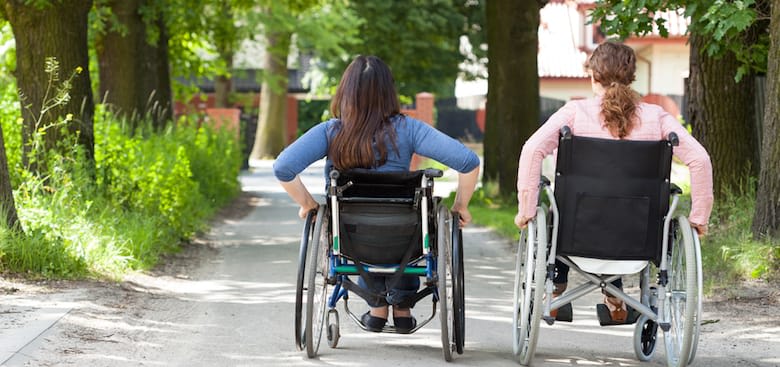College Planning Guide for Students with Physical Disabilities
September 24, 2020 :: Admissionado
College students with physical disabilities or mobility issues have a unique set of challenges to confront that most students will never encounter, or even consider. With the college selection and application process already daunting, it is easy to become overwhelmed by the amount of research and prep work that must be done to ensure a successful high school to college transition. This guide is designed specifically to help students with physical disabilities and their parents navigate that process successfully.

Physical Disabilities and College Campuses
First, the good news: going to college with a physical disability is easier now than at almost any time in the past. There was little interest in accommodation for students with disabilities at American universities until after World War II. As soldiers returned home in large numbers, many of them disabled, campuses were suddenly confronted with the “novel” problem of accessibility. Modern accessibility programs began in this era, and for decades made slow progress. Even today, students with physical disabilities cannot expect a uniform and predictable level of accessibility.
While it is impossible to determine the exact number or percentage of postsecondary students in the U.S. today with physical disabilities (due to differing definitions of physical disabilities and inconsistencies in reported data), the National Center for Education Statistics found that 19% of students reported having a disability in 2015-16 (though the type of disability was not reported). From this and other survey data, it is clear that representation on college campuses has greatly increased, as have legal requirements around accommodations.
Despite this progress, it is important to understand exactly what your rights are. While you may have had an excellent support system in your family, local school district and home town, your new campus may not be as familiar with your individual needs. You need to be informed about your rights, what you can expect from your institution and teachers in college, and where you can turn to for help in the case that you are not receiving equal consideration.
The Americans with Disabilities Act and Section 504
There are two intersecting laws and one significant grant statue that lay the foundation for ensuring equal access to education for disabled individuals in the U.S. Here’s what you need to know about each of these three important pieces of legislation:
- Section 504 of the Rehabilitation Act, passed in 1973, is a federal law that protects the rights of individuals with disabilities to participate equally in programs and activities that receive federal financial assistance. This includes school districts, state and local educational facilities, and institutions of higher education. The law is enforced by the Office of Civil Rights.
- Title II of the Americans with Disabilities Act extends that prohibition of discrimination to all state and local government services, regardless of whether they receive federal funding.
- The Individuals with Disabilities Education Act (IDEA) mandates that public schools provide free and appropriate education for students aged 3-21 who have a disability and provides funds for special education at the state level, leaving individual states to appropriately disperse that money and implement those programs.
These three pieces of legislation work together to ensure that those with disabilities receive the same access to education as their peers and provide federal funding to ensure that schools provide resources, tools and program adjustments. These laws also apply to almost every post-secondary institution in the U.S.: public universities are explicitly required to follow the antidiscrimination rules, and private universities that participate in any kind of federal funding program, including financial aid programs, are held to a similar standard. Many states have additional protective laws and grant-making statutes, following the example of the federal government, and some colleges go above and beyond the law, ensuring that they are welcoming to and exceptionally supportive of students with disabilities—we’ll discuss 10 schools with particularly good services below.
Know Where to Seek Help
Unfortunately, there is a long record of colleges resisting change to accommodate disabled students. It was largely the work of students filing lawsuits that brought about the Americans with Disabilities Act in 1990, but even after the act was signed, public and private institutions continued to protest the cost of installing ramps, making historic buildings wheelchair accessible, and other accommodations. It is well worth a little research to find out if your schools of interest have participated in (or even are still participating in) in this shameful history of discriminatory action.
If a university is not following through on their obligation to provide acceptable accommodation, the first step is to contact the school’s office of disability services. Most large schools have professionals specifically focused on Title II compliance, many of whom can be very helpful. Why do schools go through all this effort? Simple: Any individual who witnesses discrimination against disabled students, faculty, or staff may file a complaint with the federal Office of Civil Rights. If you’ve exhausted your options with university administration, and needed accommodations are still not being offered, you can and should report it! The complaint may filed online (find a link here), and OCR suggests that complaint is filed within 180 days of an incident.
Common Accommodations for Physically Disabled Students
While the accommodations provided for students with mobility issues once varied greatly by school, the laws we discussed above have made for a more uniform approach by instituting common expectations of accommodation. Though far from perfect, students can now expect access, classroom adjustments, teaching aids, and, increasingly advancing assistive software and technology.
Access
The most obvious prerequisite for a student with a physical disability to benefit equally from the educational facilities is to be able to access those facilities. While work to improve the accessibility of college campuses began when disabled veterans of World War II took advantage of the GI Bill to acquire degrees, it was slow and uneven for decades. Years and many lawsuits later, access has improved such that all college campuses can make some claims about their accessibility. However, not all college campuses are created equal. Many older campuses have antiquated buildings or have evolved with time to have multi-level buildings with a few steps up or down sporadically. Those in an urban settings or with especially historic buildings have proved costly to renovate, and universities have not always put their money where their mouths are.
Ramps are just the beginning, of course. Another way to mitigate the difficulties of navigating pre-ADA buildings is for administrators to move a class or lab to a more accessible space. This requires logistical work and advanced communication but can (and by law, must) be done if using the original classroom would prevent disabled students from partaking in their education.
Another issue for students with mobility issues is ensuring that they can easily get around a campus, and that their class times and locations don’t make it impossible for them to attend classes. Ramps, curb cuttings, wide doorways, easy-access parking, automatic doors, working elevators, grab bars in restrooms, and no impediments like turnstiles make this easier, but it is also essential that a student’s needs are understood and accounted for by professors (i.e. allowing a student to leave early or arrive a few minutes late).
New and Advancing Technological Resources
Some students with physical disabilities may have issues keeping up with notetaking in class, using necessary technology like computers, or completing tests within the allocated time. In addition to more traditional solutions like asking other students in the class to share notes or requesting teacher-approved notes, advances in technology provide a new suite of ways for disabled students to fully and equally participate in post-secondary education. Assistive software from voice recognition to eye-tracking programs enable students with various physical limitations to fully take advantage of technology. Some universities already offer the necessary equipment free of charge to disabled students, and there is growing pressure to create legal mandates in this area.
How to Choose a College
Choosing the right college is a difficult task for any student, but for students with disabilities, there are layers of extra considerations that are crucial considerations in choosing the right school.
Due Diligence
Many of the accommodations described above that a student with a disability can expect to integrate into their curriculum may already be well-established at their colleges of choice, however, one shouldn’t take this for granted. As mentioned above, some colleges have a better track record than others when it comes to embracing anti-discrimination laws—and some have an absolutely atrocious record. A quick google search for lawsuits related to disability discrimination at your choice schools is well worth your time.
Prospective students should also go beyond a school’s website and reach out to the school’s support services. If you are seriously considering applications at a few schools, or even if you have already been accepted and are choosing among universities, you should try to connect with someone within student support services or the schools disability coordinator (all publicly funded schools are required to have one). Discuss your particular needs, and how the school may or not be able to accommodate you. Not only is this information critical to making an informed choice, but the way that the school (or individual responsible for coordinating the needs of disabled students on campus) responds to your requests and questions can tell you a lot—hesitation, lack of information, or an unwillingness to engage honestly about what can and can’t be done are red flags.
The Value of a Visit
We cannot overstate that value of a visit to campus. This is the best way to get an idea of what it will be like to live and study on campus. Consider how easy (or not easy) it will be to get around, access buildings, move between classrooms, dining halls and dorms, and get a feel for the community on campus. If the student is not able to visit themselves, then, if possible, they should ask a friend, parent, or other relative who is able to visit to go in their stead. Ideally this person will know the student well and be familiar enough with their needs that they can view the campus through their eyes, watching for potential day-to-day challenges and give them a detailed account and a sense of what campus life would look like.
Top 10 Colleges for Student with Physical Disabilities
Finally, to jumpstart your search for the right school, we’ve listed 10 of the top-ranked schools for students with disabilities, many of which happen to be excellent schools on the academic front as well. More extensive lists of this kind can be found online, or by seeking professional help with the college search, strategy and application process. An admissions consultant can provide excellent guidance and help with the daunting task of finding the right schools.
- University of Michigan (Ann Arbor, Michigan)
The Wolverines were trailblazers when it comes to instituting equal accommodations for disabled students. The university created its Office of Disabled Student Services in 1973 and was the first to establish an adaptive technology computing lab.
- University of Southern California (Los Angeles, California)
USC’s leading Disability Services and Programs provides support with the goal of helping students with disabilities lead autonomous student lives.
- Northeastern University (Boston, Massachusetts)
The Disability Resource Center at Northeastern provides incoming students with disabilities tutoring sessions to ensure that they have a smooth transition to campus, are able to self-advocate, and are familiar with the resources available to them at Northeastern.
- Xavier University (Cincinnati, Ohio)
Xavier has a unique approach to empowering disabled students by providing access to ClockWork, a “scheduling and database software” designed to help students and the university’s Disability Services manage accommodations.
- University of Texas (Austin, Texas)
Among various programs run by UT Austin’s Services for Students with Disabilities has an annual event to promote Bias Incident reports—crucial recognition that without aggressive reporting, the promises of the ADA are often incompletely realized.
- College of Charleston (Charleston, South Carolina)
Although a relatively small school, Charleston has a full-fledged Center for Disability Services which offers programs and support for disabled students at the college. While larger schools generally do better for disabled students, Charleston shows that it doesn’t have to be that way.
- University of Connecticut (Storrs, Connecticut)
An early adopter of change, the University of Connecticut began accommodations programs as early as 1967. As a result, the campus boasts 11 accessible residence halls, and is home to more than 700 students with disabilities.
- Messiah University (Mechanicsburg, Pennsylvania)
Messiah University touts its commitment to taking equal access beyond the requirements of the law, and has a unique approach in their “Accommodations Profile” (AP). Upon enrolling, students with disabilities will discuss their needs with the Director of Disability Assistance and agree on the accommodations to be provided, modeling the kind of direct and open conversation the schools should strive to have with their disabled students about how to meet their needs.
- California State University, Fullerton (Fullerton, CA)
Fullerton is all about inclusion with a unique program to increase disability awareness and connect disabled students with allies and advocates on campus. The University also holds the annual SCUF Special Games.
- Augsburg College (Minneapolis, Minnesota)
Augsburg’s Center for Learning and Accessible Student Services follows a strategy of evaluating student needs and drawing on experienced staff to meet those needs.
Your Next Steps
We’ve just thrown a lot of information at you, but it all boils down to a few essential next steps:
- Do your due diligence: Conducting thorough research in the early stages of your college application process will save you a lot of unnecessary stress down the line.
- Communicate with real people: While research is good, nothing beats a conversation when it comes to getting real, on-the-ground insights.
- Self-advocate: One of the biggest lessons of moving from home to campus life is that no one is going to help you if you don’t help yourself. This is true for every first year, but doubly so for those with disabilities. You need to be proactive about making sure that the support systems you need are in place, that you know what your day-to-day will look like and that you have a support network in place.
Three decades of the ADA has had an impact. A comprehensive study from the NCES, showed that in the 2008-2009 academic year, disabled students were represented on nearly every college campus around the country, with 88% of two- and four-year institutions reporting enrollment of students with disabilities, and nearly all (99%) public institution reporting enrollment. The progress reported by this study is a good sign, showing how advocacy, legal reform and technology are helping students with mobility issues thrive on college campuses.
Sources
- https://nces.ed.gov/programs/coe/indicator_cgg.asp
- https://www.hhs.gov/ash/oah/adolescent-development/physical-health-and-nutrition/chronic-conditions-and-disabilities/trends.html
- https://www2.ed.gov/about/offices/list/ocr/frontpage/faq/disability.html
- https://files.eric.ed.gov/fulltext/EJ1085895.pdf
- https://nces.ed.gov/fastfacts/display.asp?id=60
- https://www2.ed.gov/about/offices/list/ocr/docs/howto.html
- https://www.chronicle.com/article/Where-s-the-Outrage-When/231799
- https://journals.sagepub.com/doi/abs/10.1177/0886260515581906?journalCode=jiva
- https://curry.virginia.edu/faculty-research/centers-labs-projects/research-labs/youth-violence-project/violence-schools-and-2
- https://www2.unb.ca/alc/modules/physical-disabilities/implications-for-learning.html



